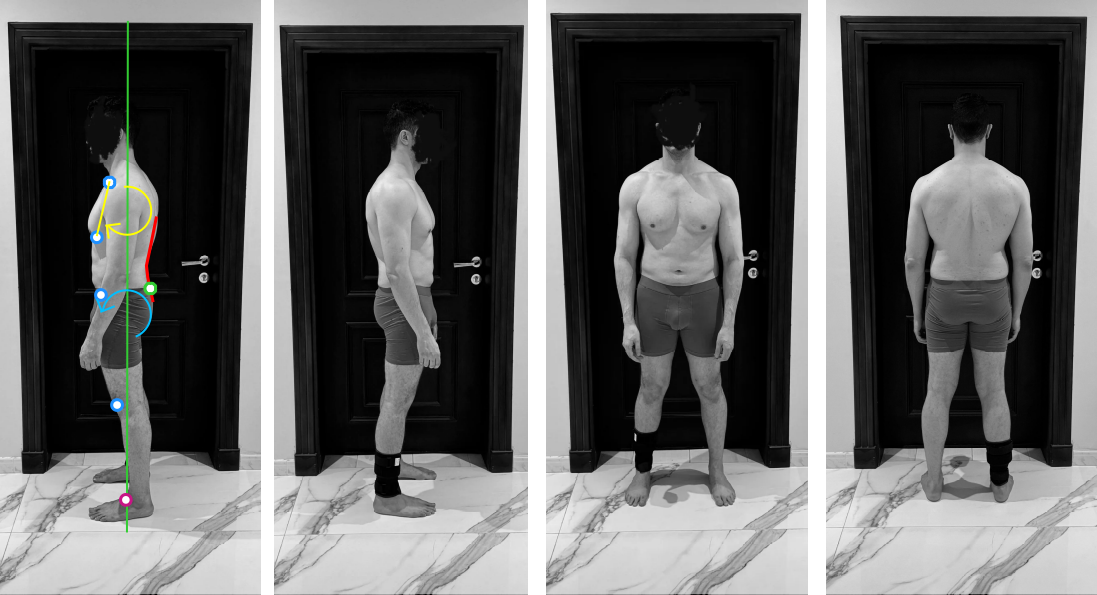Original post: https://www.reddit.com/r/Posture/comments/1gp12wq/posture_assessment_request/

Righto, so here is my 2 cents worth. For other readers, I have been talking to OP via DM's, so he already has some deeper understanding of my approach. If you need more input, feel free to request so.
Visuals are here: https://goodposture.studio/index.php/assessment/altruistic_raisin774
What we see is a pretty common set of postural defects, that I have mentioned many times in the past. So here we go again, specifically for AltruisticRaisin.
Green line is our vertical reference (plumb line). Adjusted to camera lense distortion (using the door way behind) and always placed into the "ankle spot" (purple), which is the talus bone. We use this spot as talus bone is where the mass of the entire body gets distributed into the arch of the foot.
Going up, there are 4 other bony landmarks we are interested in (blue spots). We are interested in their positions in relation to the the green plumb line (and to each other as well).
1/ "knee spot" - front of the medial epicondyle
2/ "iliac" - anterior superior iliac spine (this is the frontal part of your pelvis) The green point at the back is the top of your sacrum - also a part of your pelvis. In terms of our purposes here (movement of parts of mechanism), we consider pelvis to be one movable object
3/ "bottom sternum" - well bottom of your sternum bone
4/ " top of sternum" - selfexplanatory
Then, let's define some other terms:
Mechanism - is the whole thing, consisting of parts that interact with each other.
Torso - consists of lower torso (pelvis), upper torso (ribcage) and middle torso (spine + abdominal cavity). Legs, arms, neck and head are NOT part of your torso.
What we see is "current posture", (OP should understand by now). It is a result of movements of parts of the mechanism done just prior to taking the snapshot. If the parts moved differently, we would see a different resulting shape of the whole mechanism.
Now, we can consider what movements happened just prior to this snapshot. Specifically, let's dissect the movements that happened in the torso itself.
So pelvis has rotated according to the blue arrow. That means, ILIAC has moved forward and down, SACRUM (green spot) has moved up in space.
Ribcage has rotated as well. Except, this time in the exact opposite direction to the pelvis (yellow arrow). Again, we can say so by the lean of the sternum bone (yellow line). Where the top of the sternum is pulled backwards and the bottom of the sternum is pushed forwards.
Now, we have 2 massive objects rotating in space (ribcage and pelvis) in opposing directions. It shouldn't be too hard to imagine, that the forces created by these 2 rotatioins will start arching the spine inbetween (red curve) in the shape it is now. Effectivelly shortening and narrowing the entire torso.
There are other things visible. For example, the mechanism of the arms is retracted too far back in relation to the torso. So is the head.
If we would move the blue spots back onto the green line (all of them) and if we would reverse the rotations in the ribcage and the pelvis, we would end up flattening the red curve in the spine. The proposal is that such resulting posture would allow the entire mechanism to function better.
There are other things visible. When there is shortening in the torso, there is also functional scoliosis present. The scoliosis can be seen on any of the left/right imbalances easily showing on the front / back view.
It starts with the feet. Notice, that between images, OP had to make 4 turns (several steps). Consistently, he is placing his left foot ahead of the right. That's due to habitual movements - he is used to it.
Left foot ahead means left knee ahead, which means left iliac ahead. That will tilt pelvis laterally (left side down) and it will shift mass on the left towards the front. In order for OP to compensate this mass shift, he must pull something backwards, which is the mechanism of his right arm. So right arm is higher (due to sliding of his right collar bone backwards on top of his first rib) and retracted further back in relation to his torso.